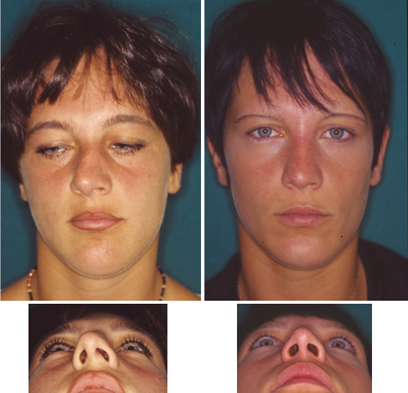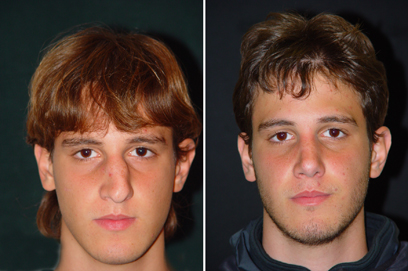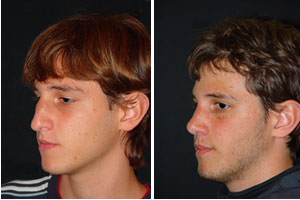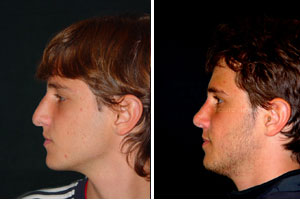

Crooked nose from a trauma at 5 years of age.
Right: 4 years after a rhinoplasty that corrected both function (respiration) and aesthetic.
I have difficulty breathing through my nose because it's crooked
A crooked nose can bring about breathing difficulties (some more serious) but above all it can give the face a disagreeable appearance. Like the nasal septum, a crooked nose can spontaneously occur in the course of facial bone development, but in the overwhelming majority of cases it is the result of a fracture of the nasal bones that has not been taken care of quickly or adequately. With the crooked nose there is not only a deviation of the nasal septum but also a deformity of the other nasal structures, namely, the bones of the nose, alar cartilages and triangular cartilage.
For this reason, in order to effectively correct a crooked nose, it is necessary to carry out a rhinoseptoplasty. Thisi is a surgical operation that intervenes in both respiration and the external appearance of the nose aiming to obtain a good functional result and aesthetically pleasing nose as well. Also in this case, before carrying out any eventual surgery, it is necessary to study the nose, not only through careful external examination, but also by carrying out an endoscopy of the nasal cavities that allows examination of the deep inner structures.
Extremely useful when planning the surgery is rhinomanometry that measure air pressure and the rate of airflow in the nasal cavity, and acoustic rhinometry that uses a reflected sound signal to measure the cross sectional area and volume of the nasal cavity giving an anatomic description of the nasal passage
What can be done?
Rhinoseptoplasty for a crooked nose is one of the more complex procedures for the nasal surgeon, as all the nasal structures must be modified in only one surgery. The operation begins with the correction of the septal deviation that always accompanies the crooked nose and is followed by modification of the bones that, by creating new controlled fractures, are molded and returned to their correct position.
Often, especially with fractures determined long before, a bony callus will have gradually formed on the bridge of the nose creating the appearance of a hump that wasn't present before the trauma. In this case, as well as straightening the nose, it's also necessary to correct the profile of the nose. It's often necessary to modify the cartilage of the tip, sometimes resorting to grafts that cover eventual residual asymmetries, in order to obtain the intended result.
The post operative course of treatment for a crooked nose rhinoseptoplasty requires the same procedures necessary for a septoplasty, including those usually necessary for an aesthetic rhinoplasty, namely: nasal packing for 4-5 days, rigid protection on the nose for the first 7 days, soft protection (plasters) from the 8th to the 14th day.



Crooked nose after repeated traumatic events.
Dorsal hump from probable bony callus. Photo before and after surgery of functional and aesthetic correction.